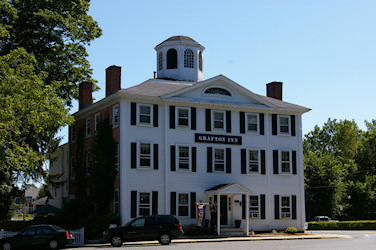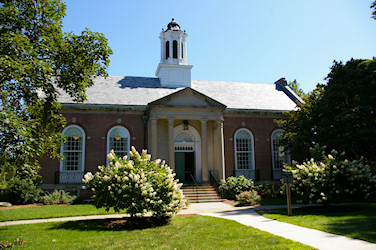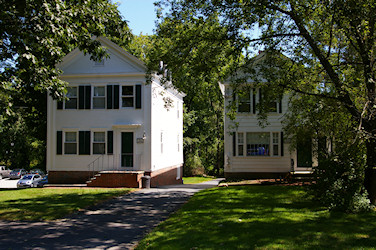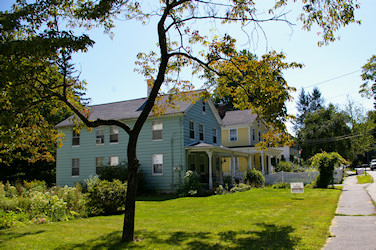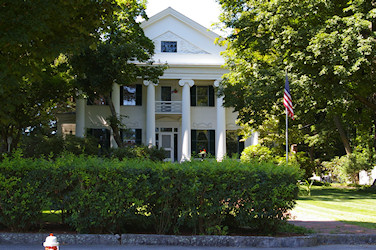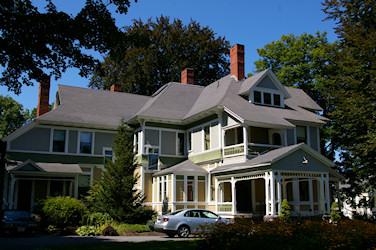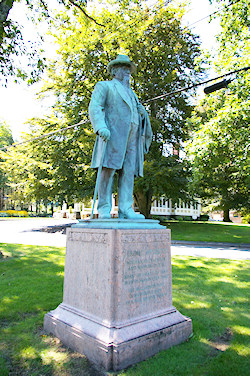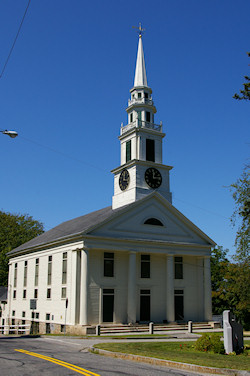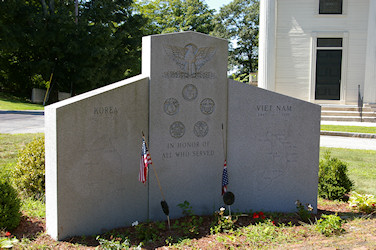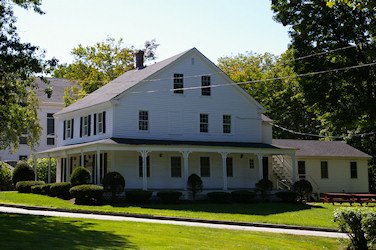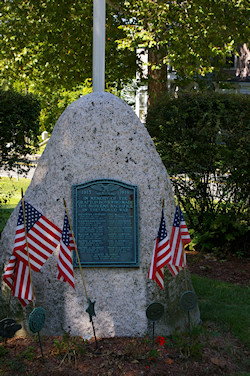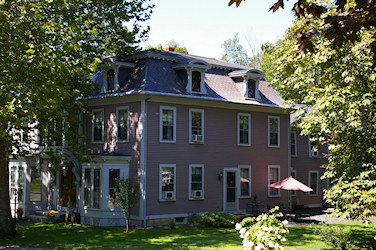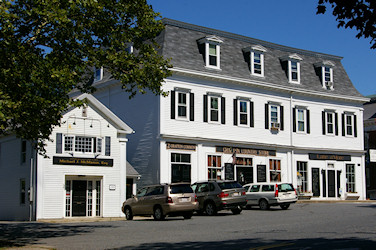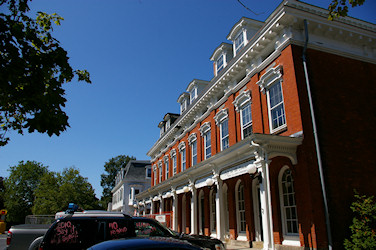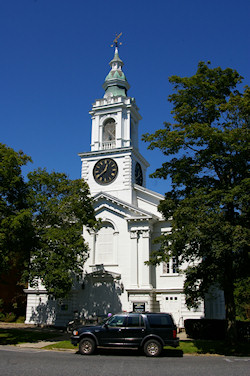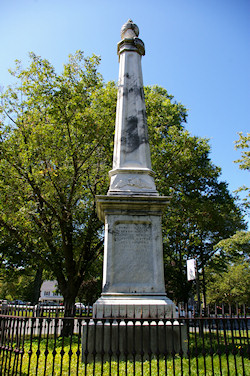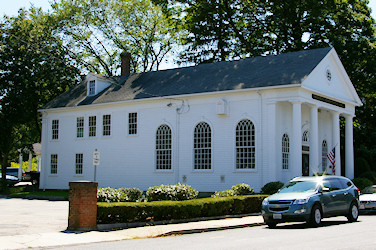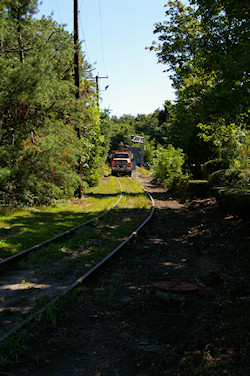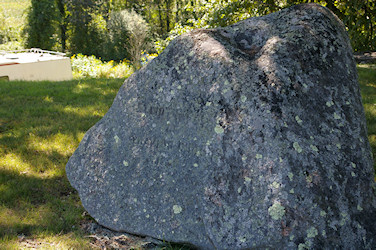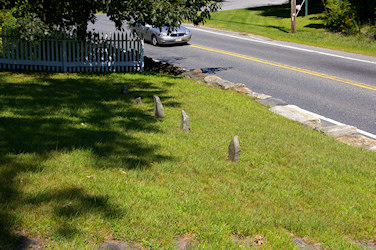Grafton Tour Review
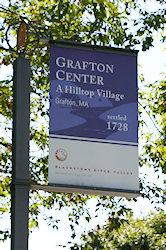 |
Basic Information | |
| Current Tour PDF | Google Map | |
| Other Tour PDFs | 2005 | |
| 2012 | ||
| When I took the tour | ||
| Tour PDF | 2005 | |
| Date | Sep 2, 2009 | |
| Time | 12:00 pm to 1:00 pm | |
| Walking Distances (miles) | ||
| Basic Tour | 0.3 | |
| See the About page for help |
My Extensions | 0 |
| Parks, Cemeteries & Other | 0 | |
The Grafton tour is a fun short stroll around the common of a New England village center that hasn’t changed much in the past century. When I lived on Route 140 in West Upton I rode a bicycle to the Grafton common many times for exercise. Although I visited the common dozens of times I had’t really noticed how many interesting buildings are in this tiny hilltop village.
The tour begins with The Grafton Inn on the corner of State Route 140. As the “open” flag being put up highlights, this 200+ year old building is still an operating inn with a restaurant and bar. This is the oldest building in the common historic district (c. 1805) and across Route 140 is one of the newest buildings the Grafton Public Library (c.1928). The library isn’t mentioned at this point in the NPS Tour but I think it’s worth looking at for its interesting early 20th century public architecture.
Walking up South Street past the library I saw two interesting buildings not mentioned in the tour brochure. The tiny pair have historic building plaques naming them the Lovell Stone Houses c. 1830. The buildings are listed simply as dwellings on the Historic District Commission map.
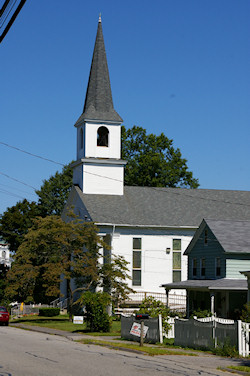
Next up on the tour are the 50¢ & Dollar houses on South Street. Be sure to take a short stroll down South street to get a good look at these lovely homes. Comparing the style and size of homes on the east vs. west sides of the street clearly illustrates the income gap between the working and upper classes in Grafton during the 19th century.
Approaching the common area again take a good look at the magnificent Queen Anne style mansion of George W. Fisher (c. 1885). The building is now used as offices for professionals which should keep the exquisite condition of the building and its landscape intact for decades to come.
On the small traffic island in South Street, just north of the Fisher Mansion and the Baptist Church, stands the Jerome Wheelock statue. His invention of the Wheelock steam cylinder along with his other ventures made him a very wealthy engineer. When he died in March 1902 there was over ½ million dollars in his estate ($13 million in 2009 dollars). The name Wheelock made me think of the Uxbridge village named Wheelockville. After researching his life a bit I don’t believe there is a direct relationship to the Uxbridge mill owning Wheelock family for which Wheelockville is named.
The beautiful Grafton Common is the next stop on the walking tour. It’s a perfect spot to sit on a bench or the soft grass and soak up the atmosphere of the town. The quaint bandstand is a common feature of New England villages but in this case it’s not a 19th century artifact. This bandstand was built for the filming of the 1935 adaptation of Eugene O’Neill’s Ah Wilderness!. The Grafton News has posted a short clip from the film showing the bandstand on their YouTube channel.
The tour continues at the north end of the common but along the way is the second of the three Grafton churches. The Congregational Church with its large Willard clock has far more detailed Greek Revival architecture than the Baptist Church. On a traffic island between the common and church is the town’s Korean & Vietnam War Memorial.
Adjacent to the church is the H. Parker House c. 1830. From the church side it is a very plain looking structure but look back as you pass to see the decorative side. The last traffic island along the west side of the common has the simple stone WWI Memorial.
Like the Parker House the next two buildings I photographed are not mentioned in the NPS tour. The Jonathan Wheeler House built in 1806 and the 1850 School/Post Office. Mr. Wheeler built the western commercial block known as the Flynn Block in 1806, this along with his home are the second oldest structures around the common. Although the home and commercial building are architecturally Second Empire, given their age I suspect they where remodeled sometime in the mid-nineteenth century. Across Route 140 from the Flynn Block is the Town House aka Warren Block built in 1862. Given its date of construction I believe its Second Empire architecture is very likely original to the building.
Next to the Town House is the most ornate of the trio of churches surrounding the common, the Unitarian Church. Its detailed Romanesque Revival architecture is visually stunning. The traffic island across Millbury Street from the church has Grafton’s Civil War Monument. Erected in 1867 this marble pillar is holding up fairly well with many of the fine sculptural details still intact.
The final building I photographed is the 1840 Greek Revival Bank adjacent to the final tour stop, the Grafton & Upton Railroad. The truck in the photo is a rail maintenance vehicle a common site now that the G & U Railroad is operating again. A new owner has invested heavily in the line and now has it moving freight from North Grafton down to West Upton.
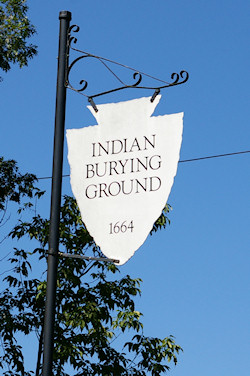
This nearly 350 year old cemetery was opened shortly after John Eliot established the Hassanamesit Praying Village in Grafton, some of the Praying Indians were buried here.
The inscription on the large stone monument is un-readable and the smaller gravestones also have no readable markings. Still it is nice place to spend a little time remembering that the Nipmuc Indians where here a long time before the Puritans came and how we nearly obliterated their culture.
The Nipmuc Nation is recognized by the Commonwealth of Massachusetts but was denied Federal recognition by the Bureau of Indian Affairs in 2004.
I had a fun time learning about the history of Grafton and I think its common is arguably the best in all of the Blackstone valley. This hour long walking tour was a good choice as a warm-up for the other tour I took on this day, the Blackstone Canal walking tour. Grafton is the shortest walking tour by distance and fourth shortest for time making it a good choice when planning a multiple tour day in the valley.
There are many more places to visit in Grafton so I expect to come back many more times. I plan to visit the Willard House and Clock Museum, the mill villages of Farnumsville and New England Village and some of the more than two dozen conservation and wildlife management areas owned by the town and the Grafton Land Trust.
More Information about Grafton
The Grafton News Channel @ YouTube
